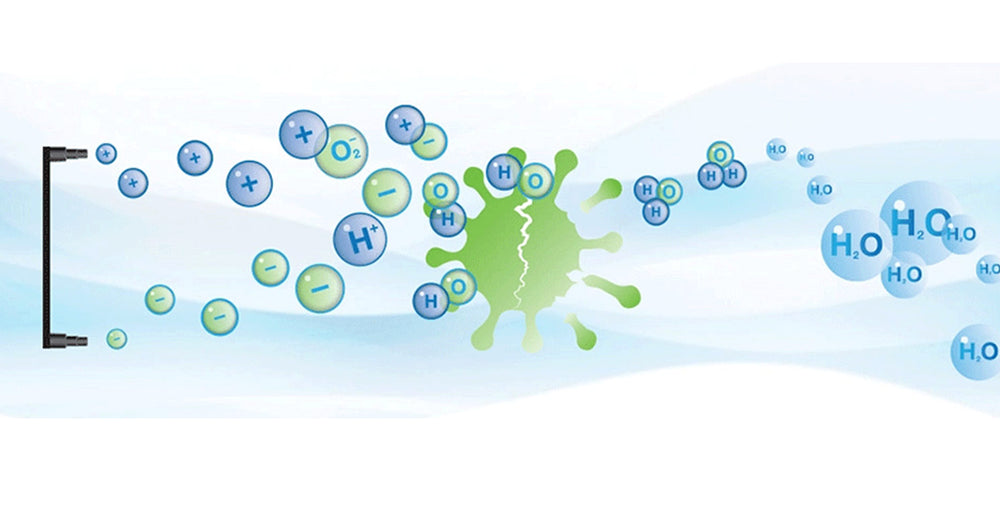The average person spends roughly 90% of their time indoors, leaving only 10% of our time to breathe in relatively clean outdoor air. For as often as we breathe the air in our homes and offices, it would greatly benefit us to take steps toward improving our indoor air quality.
Filterless air purifiers are an effective solution for removing pollutants from your air, offering significant health benefits, especially those suffering from allergies.
Want more facts and stats about what is really in your air? The data may shock you. Check out this infographic:{{cta('7d188126-169e-4a73-910b-14841f9652ce','justifycenter')}}
There are several different types of filterless air purification technologies that can help you improve your indoor air quality. However, only two of these technologies are equally effective at safely removing airborne and surface-borne contaminants from you home or office:
- Advanced Hydrated Photocatalytic Oxidation (AHPCO)
- Bi-Polar Ionization
How exactly do these technologies work to neutralize contaminants such as allergens, mold, viruses, bacteria, foul odors, and volatile organic compounds?
This article details the mechanism of each filterless purification technologies.
Advanced Hydrated Photocatalytic Oxidation Technology
Air purifiers that use photocatalytic oxidation (PCO) work by shining a UV light on a basic catalyst coated with titanium dioxide, a reaction that causes the release of charged ions known as hydroxyl radicals. While in your air, these ions can neutralize contaminants throughout your living spaces. But their effectiveness depends on how long they last in the air.
Basic PCO releases relatively short-lived hydroxyl radicals, and thus, is limited in its effectiveness. Advanced PCO technology uses a more complex catalyst formula, which produces a much more effective mixture of additional ions that actively hunt contaminants. AHPCO is an even more effective purification technology, leveraging a more complex set of five rare catalyst metals and a hydrating agent. (There are six metals: TIO2, copper, rhodium, silver, gold and nickel. Some of these are in a nano sized particle)
When the five catalysts of AHPCO are hydrated, the rate at which they’re generated and released is much greater. The hydrating agent effectively accelerates and maximizes the production of ionized hydroperoxides. These ions last much longer in the air than basic ions, and they actively seek out contaminants to neutralize and break them down.
How AHPCO Works
- Like basic PCO, ions are created from a UV Light: The UVC lamp destroys somes germs as they pass by. But most importantly, redundant air-cleansing ions are then formed from water vapor when rays of light from the UVC lamp shine on the AHPCO Catalyst.
- The ions are released, actively seeking out carbon-based contaminants such as bacteria, mold, viruses, and volatile organic compounds (VOCs). When ions come in contact with contaminants, they break them down into water and carbon dioxide and remove them from the air.
- After destroying contaminants, the ions themselves become neutralized, reverting back to harmless water vapor
In total, AHPCO more effectively sanitizes your air and surfaces than basic and advanced PCO. The technology provides a more complete home air purification, and even uses a fraction of the energy that many other purifiers do.
Bi-Polar Ionization Technology
Bi-polar ionizing air purifiers also use ions to clean your indoor air. However, it’s unique in that it releases both positive and negative ions to break down pollutants. Also known as “cold plasma” technology, bi-polar ionization prevents allergens from reproducing by disrupting the DNA of the pathogen.
Like AHPCO ions, these positive and negative ions convert them into harmless water vapor that falls out of the air to greatly improving your indoor air quality. Single-celled, carbon-based organisms such as fungi, viruses and bacteria have positive or negative charges, like any particle. When they join, they become heavy clumps that can no longer remain airborne, falling out of the air.
How Bi-Polar Ionization Works
- Cold plasma technology splits water vapor into positive and negative ions that are discharged into the air.
- Once released, these ions attach themselves to oppositely-charged contaminants such as harmful VOCs, smoke, pollen, dust, static electricity, and other pollutants.
- As the particles continue to bond to each other, they become too heavy to continue floating in the air, eventually dropping to the floor or other surfaces, ready to be swept up or wiped away.
- The charged ions revert back into oxygen, water vapor and carbon dioxide, which also helps to reduce static electricity.
In contrast to other air purification technology, bi-polar ionization is an environmentally-friendly method. And with the added benefit of reducing static electricity, bi-polar air purifiers are some of the most effective on the market.
Is Your Air Quality Healthy?
These advanced technologies are by far the best methods of improving your indoor air quality. They’re not only the most effective, but they’re the safest too.
People are often surprised by the quality of air in their homes. The news reports so often about outdoor pollutants that we may think we’re safer indoors. But nature has the benefit of natural air purification process. The sooner you adopt purifiers that use AHPCO or bi-polar ionization, the sooner you have your own process to clean you air and stop breathing harmful air pollutants.
What exactly is in the air you’re breathing? How serious is indoor air pollution? Click below to download our infographic and learn eye-opening stats about indoor air quality.
{{cta('8e432f30-c87c-4560-b8d4-3b386b058fbb')}}



